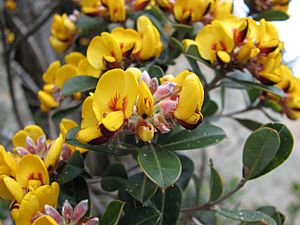Pultenaea facts for kids
Quick facts for kids Pultenaea |
|
|---|---|
 |
|
| Pultenaea daphnoides | |
| Scientific classification | |
| Kingdom: | |
| (unranked): | |
| (unranked): | |
| (unranked): | |
| Order: | |
| Family: | |
| Subfamily: | |
| (unranked): | |
| Genus: |
Pultenaea
Sm.
|
| Type species | |
| Pultenaea stipularis |
|
| Species | |
 |
|
| Range of Pultenaea Sm. | |
Pultenaea is a group of flowering plants that grow in Australia. They are part of the Fabaceae family, which includes peas and beans. These plants are often called bush peas because their flowers look a bit like pea flowers.
Bush peas are found in the southwest part of Western Australia and also in the eastern states of Australia. There are many different kinds of bush peas. Scientists think this group of plants grew and changed very quickly over time. This happened because of things like the dry Nullarbor Plain and different rainfall patterns across Australia. Some bush pea species need bushfires to help their seeds sprout. They also help the soil by adding important nutrients like nitrogen.
Contents
What are Bush Peas?
The name Pultenaea was first given to these plants in 1794 by a botanist named James Edward Smith. He wrote about them in his book A Specimen of the Botany of New Holland. The first type of bush pea he described was Pultenaea stipularis. This plant grew from a seed sent from New South Wales to England in 1792.
Smith named the genus Pultenaea to honor Richard Pulteney. He was an English surgeon and botanist. Pulteney also wrote about the famous Swedish scientist Carl Linnaeus.
How Bush Peas are Related
Pultenaea plants belong to a larger group called the Mirbelioid clade. This group is part of the legume family. Scientists use DNA studies to understand how different plants are related. These studies show that there are about 7 main groups of Pultenaea plants. These groups are found in different parts of Australia.
How New Bush Pea Species Formed
The Mirbelioid plants, including Pultenaea, have been growing in Australia for a very long time. They have been separated from other plant families. Many new types of Pultenaea plants appeared quickly during a dry period millions of years ago.
Different things helped new species form. For example, the dry Nullarbor Plain separated plants in the east from those in the west. Also, areas with winter rain and areas with summer rain caused plants to grow differently. Some types of bush peas even changed because of old oceans that once covered parts of South Australia and Victoria. Sadly, some bush pea species, like P. elusa and P. maidenii, have recently disappeared. This might be because of changes in bushfires or animals eating too many plants.
Types of Bush Peas
There are many different species of Pultenaea. Here are a few examples:
- Pultenaea daphnoides — Large-leaf bush-pea
- Pultenaea densifolia — Dense-leaf bush-pea
- Pultenaea flexilis — Graceful bush-pea
- Pultenaea gunnii — Golden bush-pea
- Pultenaea juniperina — Prickly bush-pea
- Pultenaea muelleri — Mueller's bush-pea
- Pultenaea pauciflora — Narrogin pea
- Pultenaea pedunculata — Matted bush-pea
- Pultenaea rosmarinifolia — Rosemary-leaved pultenaea
- Pultenaea scabra — Rough bush-pea
- Pultenaea tenuifolia — Slender bush-pea
Where Bush Peas Grow
Pultenaea plants only grow in Australia. They are found in the southwest of Western Australia. They also grow in the cooler and warmer parts of eastern Australia. You can find them in forests and heath lands. These are places with tough, leathery-leaved plants.
Bush peas do not grow in very dry areas or in rainforests. This shows that they need a certain amount of water to survive. They also need enough sunlight and space to grow. There are 87 species in eastern Australia and 27 species in Western Australia. Only four species are found in both regions.
How Bush Peas Live
Pultenaea plants often grow underneath taller trees. They are important for the environment. They help cycle nutrients in the soil by fixing nitrogen. This means they take nitrogen from the air and turn it into a form plants can use. They are also a food source for small animals without backbones, like insects.
Many Pultenaea species have hard seeds. These seeds need fire to help them sprout and grow. For example, P. williamsoniana needs bushfires to grow. It is important for fires to happen every ten years or so. This gives the plants enough time to grow up and make seeds.
Bush peas can grow in large numbers in some places. They are often seen along roadsides. This might be because roadsides get more light or have been disturbed. However, bush peas face some dangers. These include losing their homes due to land clearing. They are also threatened by fires that happen too often or not often enough. Weeds can also invade their habitats. Animals eating too many plants is another threat. These problems may have caused some species to disappear.
Growing Bush Peas in Gardens
Many types of Pultenaea are grown in gardens. People like them for their beautiful flowers in spring. Most bush peas grow quickly and can adapt to different garden conditions. You can grow new plants from cuttings or from seeds. Seeds often need to be soaked in hot water first to help them sprout.
Three special types of Pultenaea are officially recognized in Australia:
- Pultenaea pedunculata 'Pyalong Gold'
- Pultenaea pedunculata 'Pyalong Pink'
- Pultenaea villosa 'Wallum Gold' — a low-growing type
See also
 In Spanish: Pultenaea para niños
In Spanish: Pultenaea para niños




